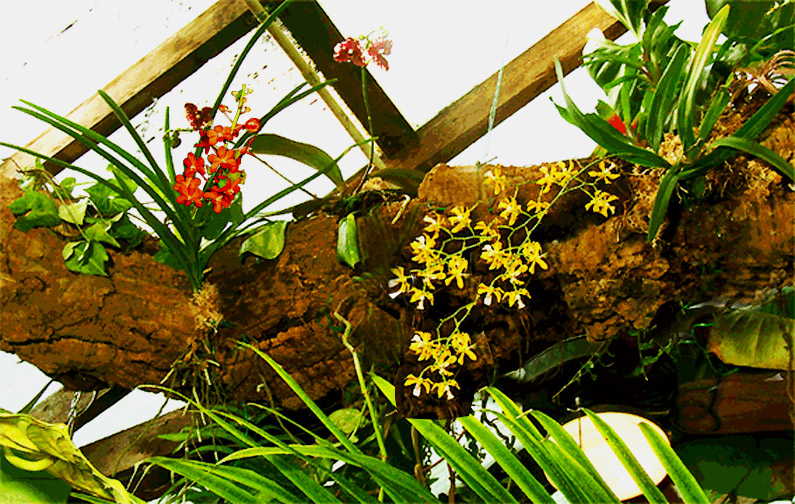![]()
Aroids and other genera in the Collection
Take the Tour Now?
Orchids
The Exotic Rainforest
Orchids
Note: Should you just add ice cubes
to a tropical orchid? Not a very smart idea!
Caring for Your Orchids
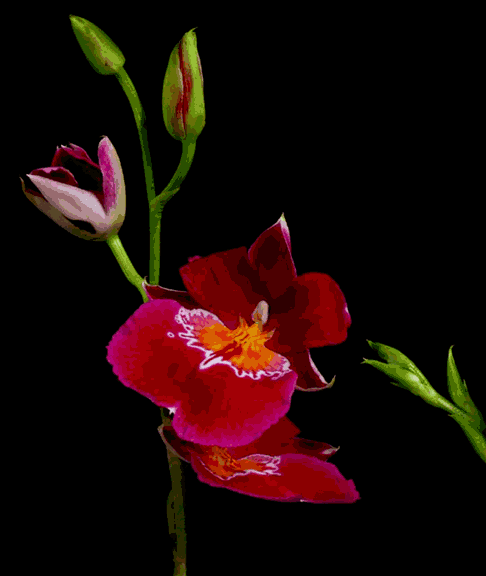
If you've seen the Kroger store (or any other store) orchids that tout
you can water
a tropical orchid by just adding ice cubes. forget it!
That is little more than a sadistic way to kill a beautiful orchid while "donating" your money to the store and the promoter.
Phalaenopsis orchids live in a rain forest and ice on the roots will likely kill your orchid!!
Just read this article and you'll learn how orchids grow in nature and it isn't anywhere near a freezer!
a tropical orchid by just adding ice cubes. forget it!
That is little more than a sadistic way to kill a beautiful orchid while "donating" your money to the store and the promoter.
Phalaenopsis orchids live in a rain forest and ice on the roots will likely kill your orchid!!
Just read this article and you'll learn how orchids grow in nature and it isn't anywhere near a freezer!
These links will bring you up to speed:
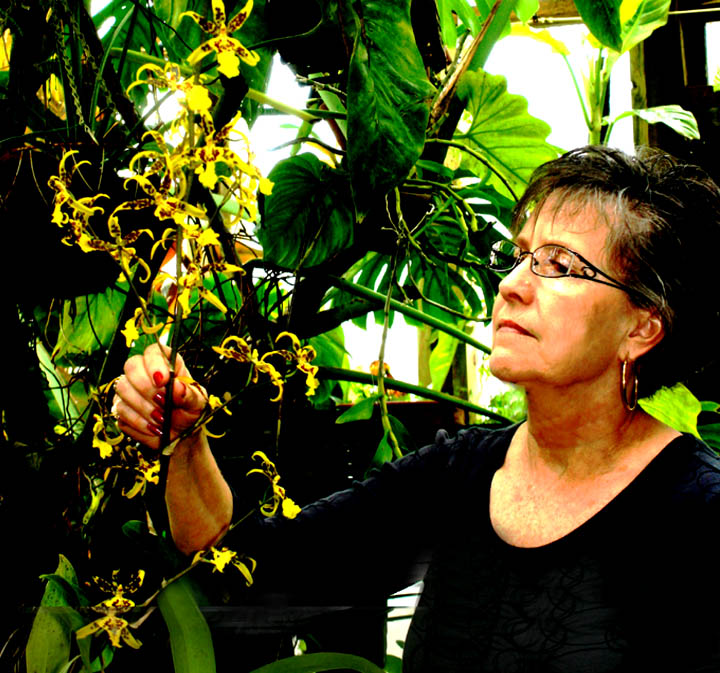 There are thousands of orchid species and
even more hybrids. These plants come from all parts of the world, including a few
that grow wild in Arkansas and other U.S. states. The majority of the
species which produce spectacular flowers are tropical and grow wild in
S.E. Asia, and Tropical America. As a result, they must have tropical
conditions to show their beauty. And despite what you may perceive,
they grow in relatively bright light in the tropical rain forest!
There are thousands of orchid species and
even more hybrids. These plants come from all parts of the world, including a few
that grow wild in Arkansas and other U.S. states. The majority of the
species which produce spectacular flowers are tropical and grow wild in
S.E. Asia, and Tropical America. As a result, they must have tropical
conditions to show their beauty. And despite what you may perceive,
they grow in relatively bright light in the tropical rain forest!
Almost all orchids you are cloned (mericlones
technically). That means they just didn't begin their lives as seeds.
Several years can be cut off the growing time by beginning with cloned
tissue cultures taken from the leaf tips of species with known flowering
beauty. Many wild grown orchids are illegal to import into this country.
Although a few will thrive in lower light (Phalaenopsis sp. are one
genus),
most prefer indirect but still bright light. Very few like direct
sunlight and the majority will die if exposed constantly to direct sun.
Contrary to the belief of many, few like a lot of shade! Indirect bright
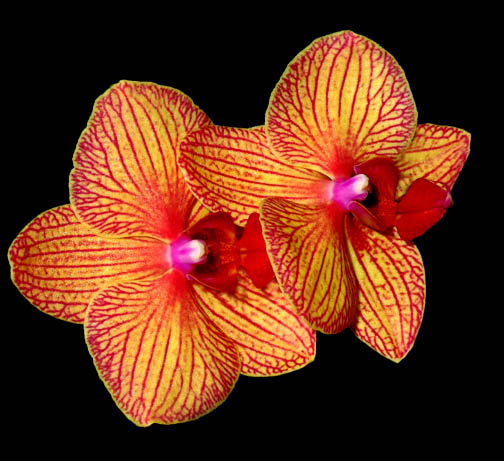 light is best for most species. The four fastest ways to kill an orchid
are to place one in a window with too much sun (or where it gets cold,
place it in your living room where it gets very little light, never water
it, or try to water it to death without excellent drainage! We
actually move all of our orchids, with the exception of those that are
permanently attached to an epiphytic tree display inside out atrium,
outdoors for the spring, summer and most of the fall. These are
grown under a single layer of screen wire with excellent blooming
results. However, they are watered heavily on a daily basis, often
twice each day. The epiphytic display which can be found on the
homepage of this website is near the ceiling of our atrium and receives
near direct but slightly filtered light due to the Lexan most of every
summer day.
light is best for most species. The four fastest ways to kill an orchid
are to place one in a window with too much sun (or where it gets cold,
place it in your living room where it gets very little light, never water
it, or try to water it to death without excellent drainage! We
actually move all of our orchids, with the exception of those that are
permanently attached to an epiphytic tree display inside out atrium,
outdoors for the spring, summer and most of the fall. These are
grown under a single layer of screen wire with excellent blooming
results. However, they are watered heavily on a daily basis, often
twice each day. The epiphytic display which can be found on the
homepage of this website is near the ceiling of our atrium and receives
near direct but slightly filtered light due to the Lexan most of every
summer day.
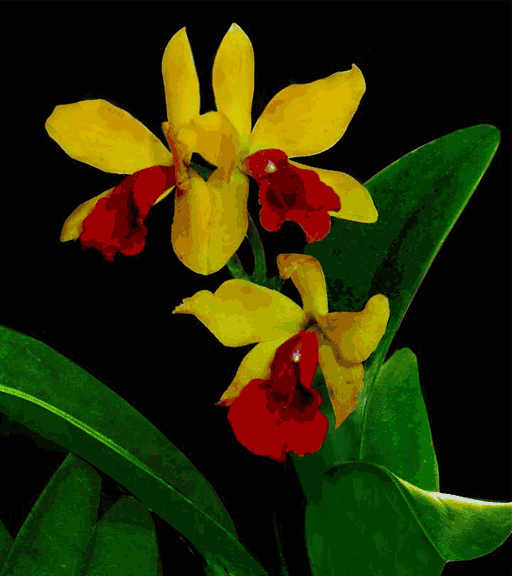 Orchids can
easily be recognized since they always have three petals, one of which is
a "lip" or "runway", and three sepals. The petals sit forward with the
"runway" normally at the bottom and sepals (which look almost like petals)
at the top and just behind the petals. The "runway" is used to entice
insects to land and explore in to spread the pollen. Some even have
traps which force the insect to walk all the way through the plant to
cover it's body with pollen before it can escape to fly away! Since
tropical species are rain forest plants, they love high humidity and warm temperatures.
But they
don't like to be kept soaking wet. Some even enjoy periods of being dry
and many will prosper if given a few months in the winter with only
occasional watering.
Orchids can
easily be recognized since they always have three petals, one of which is
a "lip" or "runway", and three sepals. The petals sit forward with the
"runway" normally at the bottom and sepals (which look almost like petals)
at the top and just behind the petals. The "runway" is used to entice
insects to land and explore in to spread the pollen. Some even have
traps which force the insect to walk all the way through the plant to
cover it's body with pollen before it can escape to fly away! Since
tropical species are rain forest plants, they love high humidity and warm temperatures.
But they
don't like to be kept soaking wet. Some even enjoy periods of being dry
and many will prosper if given a few months in the winter with only
occasional watering.
 light is best for most species. The four fastest ways to kill an orchid
are to place one in a window with too much sun (or where it gets cold,
place it in your living room where it gets very little light, never water
it, or try to water it to death without excellent drainage! We
actually move all of our orchids, with the exception of those that are
permanently attached to an epiphytic tree display inside out atrium,
outdoors for the spring, summer and most of the fall. These are
grown under a single layer of screen wire with excellent blooming
results. However, they are watered heavily on a daily basis, often
twice each day. The epiphytic display which can be found on the
homepage of this website is near the ceiling of our atrium and receives
near direct but slightly filtered light due to the Lexan most of every
summer day.
light is best for most species. The four fastest ways to kill an orchid
are to place one in a window with too much sun (or where it gets cold,
place it in your living room where it gets very little light, never water
it, or try to water it to death without excellent drainage! We
actually move all of our orchids, with the exception of those that are
permanently attached to an epiphytic tree display inside out atrium,
outdoors for the spring, summer and most of the fall. These are
grown under a single layer of screen wire with excellent blooming
results. However, they are watered heavily on a daily basis, often
twice each day. The epiphytic display which can be found on the
homepage of this website is near the ceiling of our atrium and receives
near direct but slightly filtered light due to the Lexan most of every
summer day. Orchids can
easily be recognized since they always have three petals, one of which is
a "lip" or "runway", and three sepals. The petals sit forward with the
"runway" normally at the bottom and sepals (which look almost like petals)
at the top and just behind the petals. The "runway" is used to entice
insects to land and explore in to spread the pollen. Some even have
traps which force the insect to walk all the way through the plant to
cover it's body with pollen before it can escape to fly away! Since
tropical species are rain forest plants, they love high humidity and warm temperatures.
But they
don't like to be kept soaking wet. Some even enjoy periods of being dry
and many will prosper if given a few months in the winter with only
occasional watering.
Orchids can
easily be recognized since they always have three petals, one of which is
a "lip" or "runway", and three sepals. The petals sit forward with the
"runway" normally at the bottom and sepals (which look almost like petals)
at the top and just behind the petals. The "runway" is used to entice
insects to land and explore in to spread the pollen. Some even have
traps which force the insect to walk all the way through the plant to
cover it's body with pollen before it can escape to fly away! Since
tropical species are rain forest plants, they love high humidity and warm temperatures.
But they
don't like to be kept soaking wet. Some even enjoy periods of being dry
and many will prosper if given a few months in the winter with only
occasional watering.
In the wild the plant would likely attach
itself to the trunk or limb of a tree which is why the potting mix is
normally composed primarily of bark, gravel and charcoal. Misting
thoroughly with a dilute fertilizer on a daily basis is best (Read our new
article about misting. There are still people who believe water on the
leaves and flowers will kill the plant!), but if you cannot mist daily try
to mist at least three or more days a week.
Do not allow the potting
media to remain soggy nor completely dry. Just keep it slightly
damp. Although some growers insist the technique is useless, the leaves also like to be misted and will directly absorb nutrients. We
suggest using
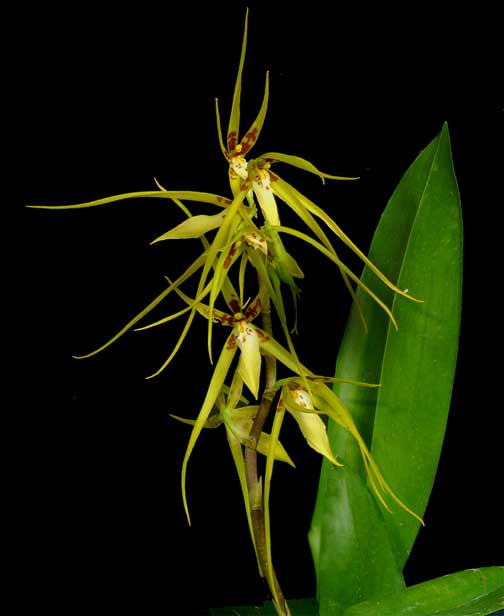 1/8th teaspoon of a good orchid fertilizer (such as Schultz)
in a spray bottle of room temp water and mist daily. If an orchid
fertilizer is not available Miracle Grow acidic formula is fine. At
least twice a
week the plant will enjoy a good soaking, just make sure the excess water
is thoroughly drained from the pot. In our "rain forest" all our
plants are heavily misted four days a week during the summer.
During the winter we mist from an overhead system only three days a
week, but for a much shorter period of time. Orchids live in the
tropics and the tropics are always humid.
1/8th teaspoon of a good orchid fertilizer (such as Schultz)
in a spray bottle of room temp water and mist daily. If an orchid
fertilizer is not available Miracle Grow acidic formula is fine. At
least twice a
week the plant will enjoy a good soaking, just make sure the excess water
is thoroughly drained from the pot. In our "rain forest" all our
plants are heavily misted four days a week during the summer.
During the winter we mist from an overhead system only three days a
week, but for a much shorter period of time. Orchids live in the
tropics and the tropics are always humid.
 1/8th teaspoon of a good orchid fertilizer (such as Schultz)
in a spray bottle of room temp water and mist daily. If an orchid
fertilizer is not available Miracle Grow acidic formula is fine. At
least twice a
week the plant will enjoy a good soaking, just make sure the excess water
is thoroughly drained from the pot. In our "rain forest" all our
plants are heavily misted four days a week during the summer.
During the winter we mist from an overhead system only three days a
week, but for a much shorter period of time. Orchids live in the
tropics and the tropics are always humid.
1/8th teaspoon of a good orchid fertilizer (such as Schultz)
in a spray bottle of room temp water and mist daily. If an orchid
fertilizer is not available Miracle Grow acidic formula is fine. At
least twice a
week the plant will enjoy a good soaking, just make sure the excess water
is thoroughly drained from the pot. In our "rain forest" all our
plants are heavily misted four days a week during the summer.
During the winter we mist from an overhead system only three days a
week, but for a much shorter period of time. Orchids live in the
tropics and the tropics are always humid.
A good visual sign to know your orchid is
happy is to look at the pseudobulb (on species that have pseudobulbs) at
the bottom of the leaves just above the potting mix. The water is stored
inside and it should remain plump. If it begins to dry out you are likely
not watering often enough. Almost all orchids will benefit from repotting
annually. However, if you use the newer ground coconut husk media which
is combined with charcoal now available you may only have to repot every 3rd year!
But check any media often to see if any decomposition has occured.
That decomposition will quickly kill a plant.
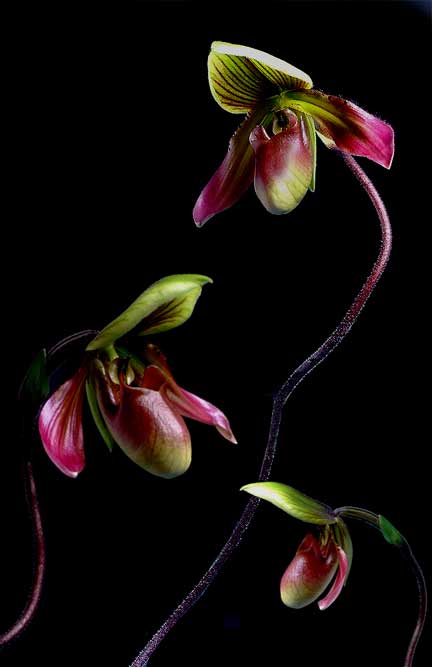 We suggest a
mixture of good orchid potting media or finely chopped coconut husk with
about 20% orchid moss thoroughly mixed in plus activated charcoal. The orchid moss helps hold
water for the roots to find as they need it. It also may help to put a thin
layer of orchid moss over the top of the potting media surrounding the
entire plant to keep the plant moist but not wet. Use as large a pot as
is practical. The plant will reward you by multiplying itself with new
plants!
We suggest a
mixture of good orchid potting media or finely chopped coconut husk with
about 20% orchid moss thoroughly mixed in plus activated charcoal. The orchid moss helps hold
water for the roots to find as they need it. It also may help to put a thin
layer of orchid moss over the top of the potting media surrounding the
entire plant to keep the plant moist but not wet. Use as large a pot as
is practical. The plant will reward you by multiplying itself with new
plants!During the summer you can keep your orchid outside in indirect but very bright light. We make it a practice to move all of our specimens out under an arbor covered only with screen wire. The screen blocks just enough sunlight to prevent the plants from burning. Watch the plants and if the leaves begin to yellow move them closer to the ground. If the temperature is going to get below 60 degrees bring them indoors. Some growers in states such as South Carolina leave their orchids out longer and find many will adapt to cooler temperatures. However, almost no tropical species will withstand a freeze! Keep the leaves away from cold glass in the winter. Most orchids do not like temperatures below 55 degrees (with the exception of a very few species)! We once lost over 100 orchids by trying to leave them out too long!
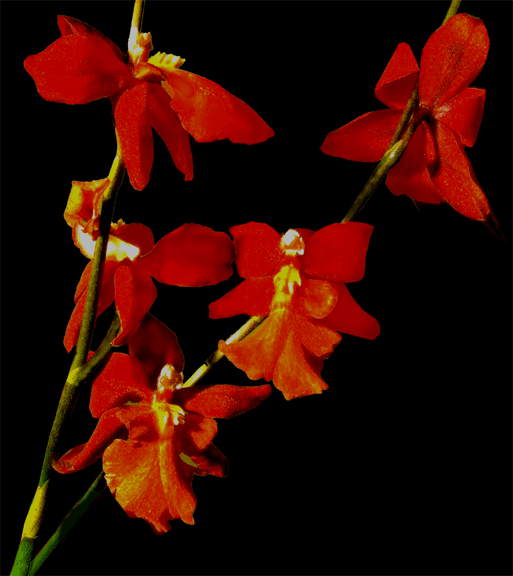 You can also judge the health of your plant by the color. It
should remain a nice medium green. A dark green is usually an indicator
of not enough light and yellowing leaves normally indicate too much
sunlight. Leaves will die naturally from time to time and will have to be
trimmed so don't think the plant is dieing just because a leaf dies.
You can also judge the health of your plant by the color. It
should remain a nice medium green. A dark green is usually an indicator
of not enough light and yellowing leaves normally indicate too much
sunlight. Leaves will die naturally from time to time and will have to be
trimmed so don't think the plant is dieing just because a leaf dies.
Many orchids produce long spikes with
multiple flowers while others produce only a few blooms. Sometimes as many
as thirty or more flowers will appear on a single spike and many bloom
three or more times a year. Depending on species and care the blooms may
last just a few weeks up to several months. A few species have
blooms that only last a day! You may find it necessary to
use a 1/4 inch dowel to support longer spikes using a bread tie or orchid
clip to hold them in place. However, the orchid will appear much
more beautifully if the spike is simply allowed to drape naturally as it
does in nature.
When new growth begins to overfill the pot,
you may want to repot the plant in a larger pot using a good orchid mix as
described above available at many nurseries. Once you get a large number
of new plants around the base, you can separate a few and start a
totally new plant by simply dividing the plant and put a portion in a new
pot. Do not trim off the roots extending out of the pot unless you are
sure they are dried out and dead. Air roots are normal! NEVER USE
POTTING SOIL and NEVER USE A POT THAT CANNOT DRAIN. That rule can
only be changed if you are attempting to grow a native orchid that is
found naturally in soil. And even then, they need to drain.
However, before you go start collecting wild orchids in the United
States, check with your state! Many are protected species!
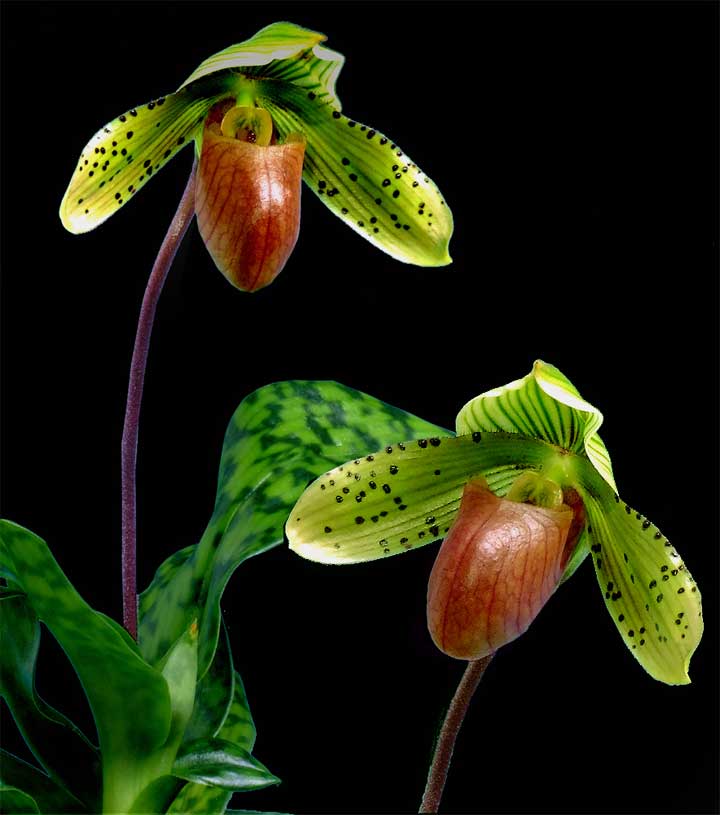 I was recently asked "how to cultivate
orchids
beneath fluorescent lights". It is possible, but you'll need
special equipment. Standard fluorescent bulbs just don't have
enough intensity, or the correct spectrum, to keep an orchid healthy and
blooming long term. You might succeed for a while, but long term the
orchid is going to need more light and the correct light spectrum. There
are however lights made for growing corals in an aquarium that will work
fine for orchids.
I was recently asked "how to cultivate
orchids
beneath fluorescent lights". It is possible, but you'll need
special equipment. Standard fluorescent bulbs just don't have
enough intensity, or the correct spectrum, to keep an orchid healthy and
blooming long term. You might succeed for a while, but long term the
orchid is going to need more light and the correct light spectrum. There
are however lights made for growing corals in an aquarium that will work
fine for orchids.
The most expensive is a VHO inflorescent ballast and bulb, probably several bulbs. These normally come in 110 watt bulbs at four foot lengths and can be d in a daylight spectrum of approximately 5600 degrees K. Not ($300 to $600 or more) but they will work great. If you can keep coral alive under them, you can keep orchids healthy as well.
 I was recently asked "how to cultivate
orchids
beneath fluorescent lights". It is possible, but you'll need
special equipment. Standard fluorescent bulbs just don't have
enough intensity, or the correct spectrum, to keep an orchid healthy and
blooming long term. You might succeed for a while, but long term the
orchid is going to need more light and the correct light spectrum. There
are however lights made for growing corals in an aquarium that will work
fine for orchids.
I was recently asked "how to cultivate
orchids
beneath fluorescent lights". It is possible, but you'll need
special equipment. Standard fluorescent bulbs just don't have
enough intensity, or the correct spectrum, to keep an orchid healthy and
blooming long term. You might succeed for a while, but long term the
orchid is going to need more light and the correct light spectrum. There
are however lights made for growing corals in an aquarium that will work
fine for orchids.The most expensive is a VHO inflorescent ballast and bulb, probably several bulbs. These normally come in 110 watt bulbs at four foot lengths and can be d in a daylight spectrum of approximately 5600 degrees K. Not ($300 to $600 or more) but they will work great. If you can keep coral alive under them, you can keep orchids healthy as well.
There are also extreme high intensity lights called
metal halide but I would not recommend those due to the potential harm
to your eyes, excess heat, high energy requirments and
very high price.
There is another form known as a "compact" light that is substantially less expensive. I've got two of these strip lights on my living coral aquarium and they are quite intense. Each bulb is approximately 65 watts and you can find nice hoods on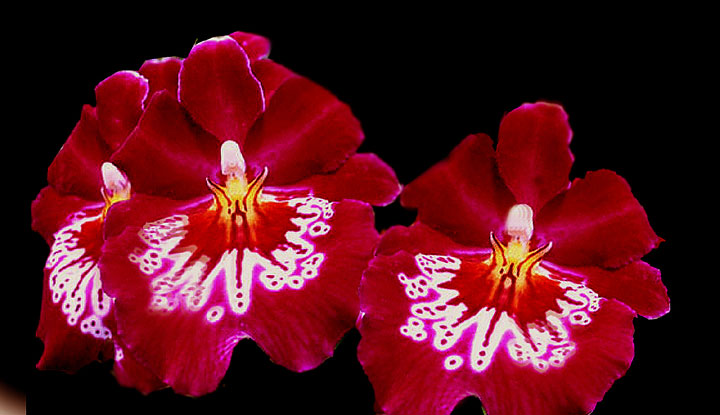 eBay for $100 or less that will hold up
to 4 bulbs. These hoods are not only effective, they look descent as
well. Many coral reef aquarium keepers now use these with great results.
So again, these can work fine for
orchids.
They are cool to the touch and put out a great deal of light. Just
make sure you "daylight" bulbs. The equivalent intensity would be
similar to lightly filtered light out doors.
eBay for $100 or less that will hold up
to 4 bulbs. These hoods are not only effective, they look descent as
well. Many coral reef aquarium keepers now use these with great results.
So again, these can work fine for
orchids.
They are cool to the touch and put out a great deal of light. Just
make sure you "daylight" bulbs. The equivalent intensity would be
similar to lightly filtered light out doors.
There is another form known as a "compact" light that is substantially less expensive. I've got two of these strip lights on my living coral aquarium and they are quite intense. Each bulb is approximately 65 watts and you can find nice hoods on
 eBay for $100 or less that will hold up
to 4 bulbs. These hoods are not only effective, they look descent as
well. Many coral reef aquarium keepers now use these with great results.
So again, these can work fine for
orchids.
They are cool to the touch and put out a great deal of light. Just
make sure you "daylight" bulbs. The equivalent intensity would be
similar to lightly filtered light out doors.
eBay for $100 or less that will hold up
to 4 bulbs. These hoods are not only effective, they look descent as
well. Many coral reef aquarium keepers now use these with great results.
So again, these can work fine for
orchids.
They are cool to the touch and put out a great deal of light. Just
make sure you "daylight" bulbs. The equivalent intensity would be
similar to lightly filtered light out doors.
The least expensive, and
perhaps one of the best, are 225 bulb LED aquarium light panels.
Each panel measures 30 cm or 12 inches square. With only a few
tools you can add as many panels as you like to cover a large area.
These panels are now being used to grow some corals with great success
and work just as well with plants. Again, be sure and use daylight
bulbs.
Don't be afraid of your orchid. Orchids are not difficult to grow as long
as you give them the care they deserve. Besides, the blooms are spectacular.
We've been growing them for many years and own hundreds. We kept our very
first orchid from 1981 until 2004 before it finally died and love to see them
bloom year after year.
Enjoy!
Steve
Steve

